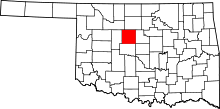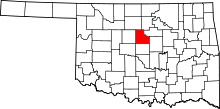Cashion, Oklahoma
| Cashion, Oklahoma | |
|---|---|
| Town | |
|
Location of Cashion, Oklahoma | |
| Coordinates: 35°48′0″N 97°40′38″W / 35.80000°N 97.67722°WCoordinates: 35°48′0″N 97°40′38″W / 35.80000°N 97.67722°W | |
| Country | United States |
| State | Oklahoma |
| Counties | Kingfisher, Logan |
| Area | |
| • Total | 1.1 sq mi (2.8 km2) |
| • Land | 1.1 sq mi (2.8 km2) |
| • Water | 0.0 sq mi (0.0 km2) |
| Elevation | 1,132 ft (345 m) |
| Population (2010) | |
| • Total | 832 |
| • Density | 756.4/sq mi (297.1/km2) |
| Time zone | Central (CST) (UTC-6) |
| • Summer (DST) | CDT (UTC-5) |
| ZIP code | 73016 |
| Area code(s) | 405 |
| FIPS code | 40-12650[1] |
| GNIS feature ID | 1091017[2] |
Cashion is a town mostly in Kingfisher and also Logan counties in the U.S. state of Oklahoma. The Logan County portion of Cashion is part of the Oklahoma City Metropolitan Statistical Area. The population was 832 at the 2010 census, a 24.7 percent gain from 643 at the 2000 census.[3]
History
Cashion began as the Town of Downs on a hill 3 miles south of Cimarron River. The first branch line of the Santa Fe and Rock Island Railroads met just 1/2 mile south of the hill at the county line. Downs, which had been declared the State Capital (for one day), was taken down and moved down the hill to the railroad at what became Cashion.
Cashion was named for Roy Cashion of Hennessey, Oklahoma.[4] Roy, a graduate of the Hennessy Senior Class of 1897, had a strong passion and belief in the freedom of the Cuban people. His graduation speech was entitled "Liberty for Cuba." When the territorial governor asked for volunteers, Cashion's name was first one on the list. He passed through this area on his way to join Teddy Roosevelt's Rough Riders in the Spanish American wars. On July 1, 1898, Cashion was killed by a gunshot to the head in the famous charge on San Juan Hill in Cuba. He is believed to be the first Oklahoman to die in battle on foreign soil.[4]
Incorporated in Oklahoma Territory in 1901, the town experienced a boom. Its growth peaked by 1915 and 1916. At this time, two railroads were running two trains a day into town from both Guthrie (Santa Fe) and from Kingfisher (Rock Island). An oil boom brought in the "Cashion Pool," which was considered the largest single pool ever discovered. It ran from south of Cashion to near Kansas just west of Enid.
Cashion was known as "The Town Too Tough To Die." While the neighboring towns of Downs, Wandell, Big Four, Lockridge, Navina, Reeding, Columbia and Lincoln Town all folded up and vanished in the Great Depression or shortly thereafter, Cashion hung on. However, the population declined as farms failed in the surrounding area. The Santa Fe Railroad abandoned its line in 1934, and the Rock Island removed its track in 1937. The population dropped from 291 in 1930 to 232 in 1940, then to its all-time low of 182 in 1950.[4]
A resurgent economy created more jobs in nearby Guthrie and Kingfisher, causing new residents to move into Cashion. In 1960, the census recorded 221 residents. The 1970 census recorded 329.[4]
Geography
Cashion is located at 35°48′0″N 97°40′38″W / 35.80000°N 97.67722°W (35.800002, -97.677178).[5] It is 16 miles (26 km) east southeast of Kingfisher, Oklahoma.[4]
According to the United States Census Bureau, the town has a total area of 1.1 square miles (2.8 km²), all land.
Demographics
| Historical population | |||
|---|---|---|---|
| Census | Pop. | %± | |
| 1910 | 289 | — | |
| 1920 | 296 | 2.4% | |
| 1930 | 291 | −1.7% | |
| 1940 | 232 | −20.3% | |
| 1950 | 182 | −21.6% | |
| 1960 | 221 | 21.4% | |
| 1970 | 329 | 48.9% | |
| 1980 | 547 | 66.3% | |
| 1990 | 430 | −21.4% | |
| 2000 | 635 | 47.7% | |
| 2010 | 802 | 26.3% | |
| Est. 2015 | 847 | [6] | 5.6% |
As of the census[1] of 2000, there were 635 people, 238 households, and 177 families residing in the town. The population density was 578.7 people per square mile (222.9/km²). There were 262 housing units at an average density of 238.8 per square mile (92.0/km²). The racial makeup of the town was 95.28% White, 0.16% African American, 1.73% Native American, 0.16% from other races, and 2.68% from two or more races. Hispanic or Latino of any race were 4.09% of the population.
There were 238 households out of which 45.0% had children under the age of 18 living with them, 55.5% were married couples living together, 12.2% had a female householder with no husband present, and 25.6% were non-families. 24.8% of all households were made up of individuals and 10.9% had someone living alone who was 65 years of age or older. The average household size was 2.67 and the average family size was 3.18.
In the town the population was spread out with 32.1% under the age of 18, 6.8% from 18 to 24, 29.0% from 25 to 44, 21.3% from 45 to 64, and 10.9% who were 65 years of age or older. The median age was 35 years. For every 100 females there were 97.8 males. For every 100 females age 18 and over, there were 93.3 males.
The median income for a household in the town was $37,500, and the median income for a family was $44,844. Males had a median income of $31,012 versus $25,729 for females. The per capita income for the town was $16,513. About 11.4% of families and 15.6% of the population were below the poverty line, including 23.4% of those under age 18 and 24.6% of those age 65 or over.
References
- 1 2 "American FactFinder". United States Census Bureau. Archived from the original on 2013-09-11. Retrieved 2008-01-31.
- ↑ "US Board on Geographic Names". United States Geological Survey. 2007-10-25. Retrieved 2008-01-31.
- ↑ CensusViewer:Cashion, Oklahoma population. Retrieved May 29, 2014.
- 1 2 3 4 5 Everett, Dianna. "Cashion," Encyclopedia of Oklahoma History and Culture. Archived December 10, 2012, at the Wayback Machine. Accessed May 26,2015.
- ↑ "US Gazetteer files: 2010, 2000, and 1990". United States Census Bureau. 2011-02-12. Retrieved 2011-04-23.
- ↑ "Annual Estimates of the Resident Population for Incorporated Places: April 1, 2010 to July 1, 2015". Retrieved July 2, 2016.
- ↑ "Census of Population and Housing". Census.gov. Archived from the original on April 22, 2013. Retrieved June 4, 2015.
External links
- Town Website
- Encyclopedia of Oklahoma History and Culture - Cashion
- Oklahoma Digital Maps: Digital Collections of Oklahoma and Indian Territory

